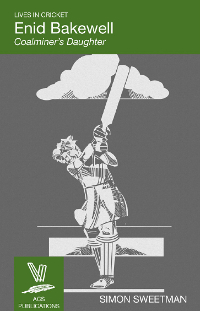Enid Bakewell: Coalminer’s Daughter
Martin Chandler |Published: 2018
Pages: 120
Author: Sweetman, Simon
Publisher: ACS
Rating: 3.5 stars

I don’t know exactly how many cricketing biographies/autobiographies I own, but there must be hundreds of them. I haven’t read them all, yet, but over the years have certainly worked my way through a goodly number. Of all those books just one concerns a woman, Heyhoe, the 1978 published autobiography of Rachel Heyhoe-Flint, for many years the only woman cricketer with a claim to be a household name of any sort. One day I will read Heyhoe, but probably not for a while.
Despite the lack of biographical works the game’s literature has occasionally visited the women’s game and I remind myself that CricketWeb has not ignored the subject completely. I myself reviewed Women at the Wicket last year, and The Girls of Summer before that. In addition noted author Douglas Miller kindly reviewed Skirting The Boundary for us in 2014. In the 21st century there will, as the stock of the women’s game continues to rise apace doubtless be more books, but whilst the ladies have stormed Wisden’s portals several times in recent years this biography of Enid Bakewell remains, as far as I am aware, the first of its type.
A contemporary of Rachel Heyhoe-Flint Enid was, judged on statistics alone, a better cricketer. Heyhoe was a middle order bat, who averaged around 45 in 22 Tests. Enid occupied the top of the order as well, and in her 12 Tests averaged a tick under 60. Heyhoe was a fine captain and adept at dealing with the press, but she only occasionally deployed her leg breaks, taking just three Test wickets. Enid however was a clever orthodox left arm spinner, who added value to her batting performances to the tune of 50 wickets at 16.
Enid has co-operated fully with author Simon Sweetman in the preparation of a book which, not surprisingly, is quite unlike any male cricketer’s biography – the first reason for saying that appears on the very first page, which contains an account of our heroine, in her 75th year, taking 3-29 for MCC Women against Felsted school, although in a gesture of respect to Anno Domini she had dropped to number eleven in the batting order, and did not get to the crease.
After that introduction Sweetman’s approach is a conventional one. He looks at the Nottinghamshire coalfields from where Enid originated before taking a look at the family background. As the sub-title suggests Enid, an only child, came from a mining background. With women’s cricket being an essentially middle class pursuit, and absent any significant family involvement in the game, it is in some ways surprising that Enid’s cricket career ever got off the ground.
There was no living to be made for women cricketers in Enid’s time, so a career as PE teacher was a considerable advantage to her in freeing up the time that she needed to devote to her cricket. There is nothing truly remarkable about Enid’s life, but hers is an interesting story nonetheless, and the lady herself regularly takes over Sweetman’s narrative with memories and asides. On field successes are, of course, explained and the ups and downs of women’s cricket are weaved into the story. It is not a subject I know very much about, but I much enjoyed the story. The only area of the book where I think Sweetman might have pushed his subject a little harder is in relation to Enid’s two trips to South Africa in the 1980s. Both visits were palpably in breach of the Gleneagles Agreement and Enid’s participation is something which, based on other passages in the book, is difficult to reconcile with her political beliefs.
There are not too many numbers or scorecards within the book’s covers, although that is more indicative of the failings of statisticians past as much as anything else. It is a wrong that a number of the current membership of the publisher are working hard to put right, and if there is ever a second edition of the book perhaps a more wide-ranging statistical appendix could be included. The book also contains a good selection of photographs which, with a single exception, are very well reproduced. That exception is, sadly, the one that might have been the best of them all and, given that it was taken as recently as 2012, its disappointing quality is something of a surprise. The image is of Enid posing with Brian Lara on the occasion of the pair being inducted into the ICC Hall of Fame. That is a minor grumble however and, overall, Enid Bakewell: Coalminer’s Daughter is a most valuable addition to the literature of cricket.






Where can I buy the paperback copy of this please.
Comment by Jayne Jarman | 7:38pm BST 22 May 2024
Out of print it would seem, but it is available from the ACS website as an ebook
Comment by Martin Chandler | 10:05pm BST 22 May 2024